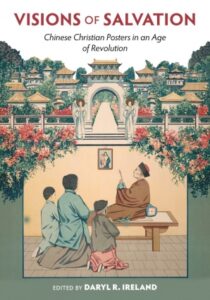Visions of Salvation: Chinese Christian Posters in an Age of Revolution edited by Daryl Ireland. Waco, TX: Baylor University Press, forthcoming April 15, 2023, 302 pages. ISBN-10 1481316249, ISBN-13 978-1481316248. Available for pre-order from Baylor University Press.
This innovative collection of posters and articles, edited by Daryl Ireland, starts with an imaginative title: Visions of Salvation. On its surface, the book offers readers colorful reproductions of a vast assortment of rare Christian posters gathered in China between the 1920s and 1950. Beyond that, Ireland also advances a substantial thesis. He contends the articles challenge several established conceptions of Chinese church history.
A central thesis is that the Christian community contributed a third way to imagine national salvation, an equivalent force to the two major political parties, the Nationalists (KMT) and the Communists (CCP) (p. 10). While the prevailing Christian literature of the era often focuses on the modernist-fundamentalist rift, Ireland notes that the posters tell a very different story. Despite the reality of the schism, “when they hung up posters, their doctrinal differences disappeared” (p. 11). The similarities of the posters demonstrate the theological opponents shared deeper assumptions about the gospel in China. “Modernist and Fundamentalists… had a common political vision. They both embraced Chinese nationalism and portrayed Christ as the only power that could overcome imperialism” (p. 13).
Sources
The unique contribution of this edited volume is derived from the unconventional resources employed. The story of the genesis of the project, as related by Ireland in the acknowledgments, started with the unexpected arrival of a trove of Chinese posters at Boston University. As the Associate Director of the Center for Global Christianity and Mission, Ireland began an extensive search for additional poster collections around the world. The center received funding and was able to help twenty archives and other collaborators digitize a collection of over 700 posters, all originated from China between the 1920s and 1950s and provide them to the public at Chinese Christian Posters.
The disorganized resources still did not tell a story, so a conference of several China scholars, including historians, theologians, and artists, was organized. For two days they dreamed of how they might craft a narrative from the images. The chapters of this volume are the fruit of their conversation. The diverse scholars, both young and senior, includes well-known names such as Peter Zarrow, Chloë Starr, Dana Robert, Zexi (Jesse) Sun, and James Qi He. The topics include women, childhood, evangelism, biblical interpretations, Roman Catholicism, and fine art. Each chapter includes carefully selected images and extensive footnotes citing the current literature. The monumental accomplishment of the entire project is attested to by the extensive catalog, well over ten pages, of the painstakingly translated and documented bibliographical credits for each image. English renderings of the Chinese text, which is sometimes extensive, are also included alongside each figure. The posters provide a powerful mechanism for unifying the otherwise varied perspectives and topics.
Development of Chapters
The beautiful reproductions of the artifacts allow viewers to immerse themselves in the visual world of Chinese Christianity in the second quarter of the twentieth century, running from the May Fourth Movement in 1919 until the Communist victory in 1949 (p. 1). In the introduction Ireland maintains, “Christianity may be the religion of the Book, but in China it would have been popularly recognized by its ubiquitous images” (p. 2). This is the first scholarly analysis of Chinese Christian propaganda, providing a new way to see this period In Chinese history.
Following the introduction, the compendium contains ten chapters, starting with Peter Zarrow’s discussion of Christian and non-Christian elites joining the common cause of transforming the nation. Jesse Sun, in the second chapter, demonstrates that Christians were eager to save China. Connie Shemo, in chapter three, looks at women’s contributions to healing the nation through the profession of nursing. Chapter four, penned by Margaret Tillman, focuses on the depiction of children in the Christian posters that suggests they were happy and carefree, but at the same time with saddled with heavy responsibility.
The next section, starting in chapter five, moves to theology with Dana Robert’s examination of how the China Inland Mission employed posters to “make conversions, claim public space, and instill Christian identity” (p. 30). Chapter six, coauthored by David Li and Daryl Ireland, ferrets out some of the theological implications of the posters, noting that it was not Jesus Christ at the center of the artwork, but his cross. Chloë Starr, in the seventh article, titled “The Art of Scripture,” unpacks various ways posters interpreted biblical texts, noting Christians found ways to contextualize the Bible and make it meaningful for viewers.
Roman Catholics also employed posters, and Stephanie Wong in chapter eight looks at their efforts to indigenize Catholicism. She addresses a common conundrum for contextualization during the era, observing that while Western missionaries might have been trying to Sinicize Christianity to ancient Chinese art forms, the intellectuals and popular culture were pushing China to modernize. James Qi He, an artist, in the next chapter, titled “Images of Beauty,” also examines the Catholic posters, noting that they draw on Chinese traditions to make Christianity not only recognizable but also beautiful.
Joseph Ho, in the tenth and concluding article, “Visual Culture,” observes that the study of Chinese Christian posters is an ongoing inquiry, and additional efforts at analysis will continue to produce new insight. As Daryl Ireland suggests, “In that sense, the rediscovery of these images is an invitation to the reader: Look! There is more to find, and there are still new ways of approaching what happened to China prior to 1949. This volume is just the beginning” (p. 31).
Evaluation
The book is accessible, cohesive, and it offers a vigorous discussion of a provocative thesis. The online collection of posters is also a priceless resource. Preparing for a Good Friday sermon, for example, I quickly located an elaborate poster of a Sinicized Jesus on the cross, flanked by the two criminals, with the text translated from Chinese. It is a resource deserving a bookmark on your browser.
The insights developed in the volume are still preliminary, but they certainly open the door to additional conversation. Deeper analysis might further explore whether the posters accurately reflect the developments in the church at the time. Beyond discussion of China, future research might also consider the impact of Christian posters and propaganda in other parts of the world during the same era. A similar study of North America, “Visions of Salvation in the United States,” for instance, might help reveal whether Christian posters and tracts helpfully reflect the conditions of the church and nation or if they open the door to misinterpretation and misunderstandings. This volume breaks ground into a rich new vein of exploration.
On April 26, Dr. Ireland will give a lecture entitled “Spreading the Gospel: Christian Posters in Early 20th Century China” at Wheaton College. If you are in the Chicago area, please join us. There will be a limited number of signed copies of Dr. Ireland’s book for purchase. If you’re not able to attend, the lecture will be recorded, and you’ll be able to listen after the event. Register at EventBrite to attend in person and to be notified when the recording is available. It’s free!
Our thanks to Baylor University Press for providing an advanced copy of Visions of Salvation: Chinese Christian Posters in an Age of Revolution edited by Daryl Ireland for this review.
Image credit: all courtesy of Chinese Christian Posters.

Richard Cook
Richard Cook is Associate Professor of Church History and Missions at Logos Evangelical Seminary in El Monte, California and serves as Director of the M.A.I.C.S. Program. He came to Logos in 2011. Dr. Cook served as a missionary and seminary professor in Taiwan for over ten years, and before coming …View Full Bio
Are you enjoying a cup of good coffee or fragrant tea while reading the latest ChinaSource post? Consider donating the cost of that “cuppa” to support our content so we can continue to serve you with the latest on Christianity in China.
